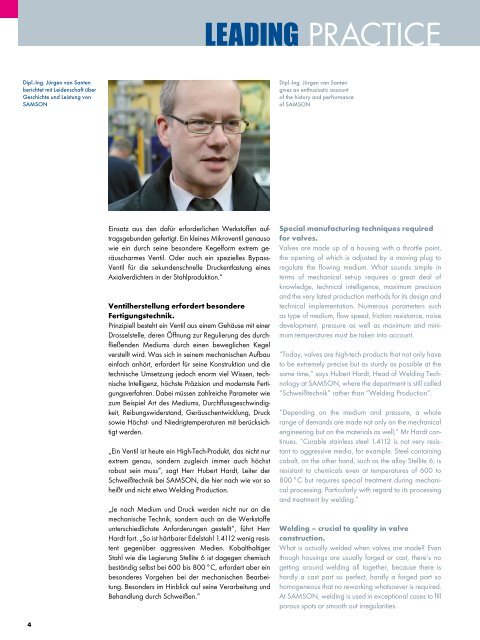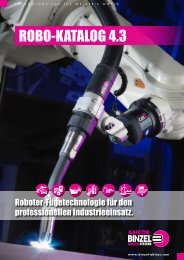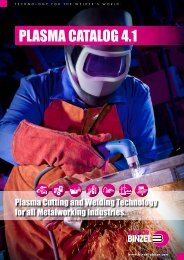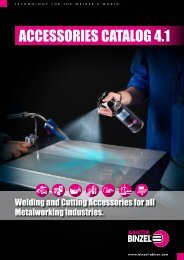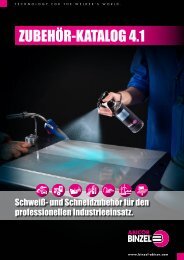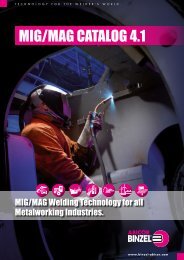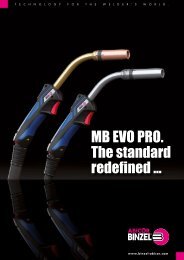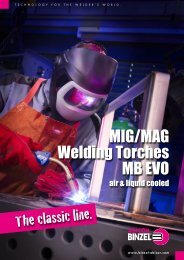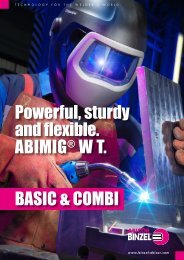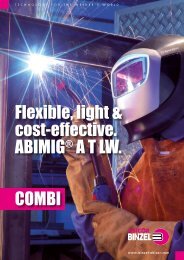Erfolgreiche ePaper selbst erstellen
Machen Sie aus Ihren PDF Publikationen ein blätterbares Flipbook mit unserer einzigartigen Google optimierten e-Paper Software.
LEADING PRACTICE<br />
Dipl.-Ing. Jürgen van Santen<br />
berichtet mit Leidenschaft über<br />
Geschichte und Leistung von<br />
<strong>SAMSON</strong><br />
Dipl.-Ing. Jürgen van Santen<br />
gives an enthusiastic account<br />
of the history and performance<br />
of <strong>SAMSON</strong><br />
Einsatz aus den dafür erforderlichen Werkstoffen auftragsgebunden<br />
gefertigt. Ein kleines Mikroventil genauso<br />
wie ein durch seine besondere Kegel form extrem geräuscharmes<br />
Ventil. Oder auch ein spezielles Bypass-<br />
Ventil für die sekundenschnelle Druckentlastung eines<br />
Axialverdichters in der Stahlproduktion.“<br />
Ventilherstellung erfordert besondere<br />
Fertigungstechnik.<br />
Prinzipiell besteht ein Ventil aus einem Gehäuse mit einer<br />
Drosselstelle, deren Öffnung zur Regulierung des durchfließenden<br />
Mediums durch einen beweglichen Kegel<br />
verstellt wird. Was sich in seinem mechanischen Aufbau<br />
einfach anhört, erfordert für seine Konstruktion und die<br />
technische Umsetzung jedoch enorm viel Wissen, technische<br />
Intelligenz, höchste Präzision und modernste Fertigungsverfahren.<br />
Dabei müssen zahlreiche Parameter wie<br />
zum Beispiel Art des Mediums, Durchflussgeschwindigkeit,<br />
Reibungswiderstand, Geräuschentwicklung, Druck<br />
sowie Höchst- und Niedrigtemperaturen mit berücksichtigt<br />
werden.<br />
„Ein Ventil ist heute ein High-Tech-Produkt, das nicht nur<br />
extrem genau, sondern zugleich immer auch höchst<br />
robust sein muss“, sagt Herr Hubert Hardt, Leiter der<br />
Schweißtechnik bei <strong>SAMSON</strong>, die hier nach wie vor so<br />
heißt und nicht etwa Welding Production.<br />
„Je nach Medium und Druck werden nicht nur an die<br />
mechanische Technik, sondern auch an die Werkstoffe<br />
unterschiedlichste Anforderungen gestellt“, führt Herr<br />
Hardt fort. „So ist härtbarer Edelstahl 1.4112 wenig resistent<br />
gegenüber aggressiven Medien. Kobalthaltiger<br />
Stahl wie die Legierung Stellite 6 ist dagegen chemisch<br />
beständig selbst bei 600 bis 800 °C, erfordert aber ein<br />
besonderes Vorgehen bei der mechanischen Bearbeitung.<br />
Besonders im Hinblick auf seine Verarbeitung und<br />
Behandlung durch Schweißen.“<br />
Special manufacturing techniques required<br />
for valves.<br />
Valves are made up of a housing with a throttle point,<br />
the opening of which is adjusted by a moving plug to<br />
regulate the flowing medium. What sounds simple in<br />
terms of mechanical set-up requires a great deal of<br />
knowledge, technical intelligence, maximum precision<br />
and the very latest production methods for its design and<br />
technical implementation. Numerous parameters such<br />
as type of medium, flow speed, friction resistance, noise<br />
development, pressure as well as maximum and minimum<br />
temperatures must be taken into account.<br />
“Today, valves are high-tech products that not only have<br />
to be extremely precise but as sturdy as possible at the<br />
same time,” says Hubert Hardt, Head of Welding Technology<br />
at <strong>SAMSON</strong>, where the department is still called<br />
“Schweißtechnik” rather than “Welding Production”.<br />
“Depending on the medium and pressure, a whole<br />
range of demands are made not only on the mechanical<br />
engineering but on the materials as well,” Mr Hardt continues.<br />
“Curable stainless steel 1.4112 is not very resistant<br />
to aggressive media, for example. Steel containing<br />
cobalt, on the other hand, such as the alloy Stellite 6, is<br />
resistant to chemicals even at temperatures of 600 to<br />
800 °C but requires special treatment during mechanical<br />
processing. Particularly with regard to its processing<br />
and treatment by welding.”<br />
Welding – crucial to quality in valve<br />
construction.<br />
What is actually welded when valves are made? Even<br />
though housings are usually forged or cast, there‘s no<br />
getting around welding all together, because there is<br />
hardly a cast part so perfect, hardly a forged part so<br />
homogeneous that no reworking whatsoever is required.<br />
At <strong>SAMSON</strong>, welding is used in exceptional cases to fill<br />
porous spots or smooth out irregularities.<br />
4


